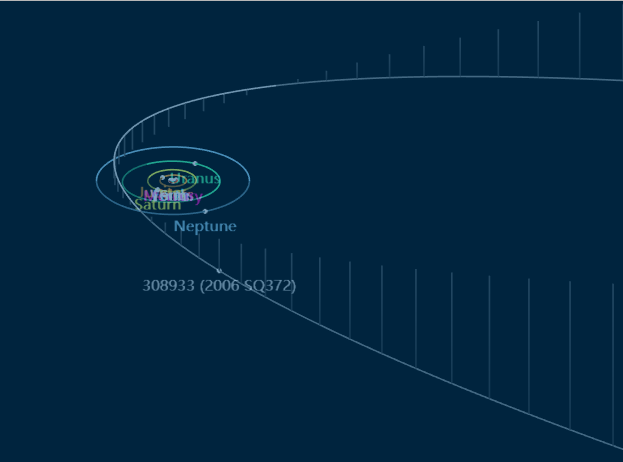(308933) 2006 SQ372 on:
[Wikipedia]
[Google]
[Amazon]
is a trans-Neptunian object and highly eccentric
 It has a highly eccentric orbit, crossing that of
It has a highly eccentric orbit, crossing that of

centaur
A centaur ( ; grc, κένταυρος, kéntauros; ), or occasionally hippocentaur, is a creature from Greek mythology with the upper body of a human and the lower body and legs of a horse.
Centaurs are thought of in many Greek myths as being ...
on a cometary-like orbit in the outer region of the Solar System, approximately in diameter. It was discovered through the Sloan Digital Sky Survey
The Sloan Digital Sky Survey or SDSS is a major multi-spectral imaging and spectroscopic redshift survey using a dedicated 2.5-m wide-angle optical telescope at Apache Point Observatory in New Mexico, United States. The project began in 2000 a ...
by astronomers Andrew Becker, Andrew Puckett and Jeremy Kubica on images first taken on 27 September 2006 (with precovery
In astronomy, precovery (short for pre-discovery recovery) is the process of finding the image of an object in images or photographic plates predating its discovery, typically for the purpose of calculating a more accurate orbit. This happens mos ...
images dated to 13 September 2005).
Characteristics
 It has a highly eccentric orbit, crossing that of
It has a highly eccentric orbit, crossing that of Neptune
Neptune is the eighth planet from the Sun and the farthest known planet in the Solar System. It is the fourth-largest planet in the Solar System by diameter, the third-most-massive planet, and the densest giant planet. It is 17 times ...
near perihelion but bringing it more than 1,500 AU from the Sun at aphelion. It takes about 22,500 years to orbit the barycenter of the Solar System. The large semi-major axis
In geometry, the major axis of an ellipse is its longest diameter: a line segment that runs through the center and both foci, with ends at the two most widely separated points of the perimeter. The semi-major axis (major semiaxis) is the long ...
makes it similar to and . With an absolute magnitude (H) of 8.1, it is estimated to be about 60 to 140 km in diameter. Michael Brown estimates that it has an albedo of 0.08 which would give a diameter of around 110 km.
The object could possibly be a comet. The discoverers hypothesize that the object could come from the Hills cloud, but other scientists like California Institute of Technology's Michael Brown also consider other possibilities, including the theory "it may have formed from debris just beyond Neptune n the Kuiper belt">Kuiper_belt.html" ;"title="n the Kuiper belt">n the Kuiper beltand been 'kicked' into its distant orbit by a planet like Neptune or Uranus".
Perturbation
The orbit of currently comes closer to Neptune than any of the other giant planets. More than half of the simulations of this object show that it gets too close to either Uranus orNeptune
Neptune is the eighth planet from the Sun and the farthest known planet in the Solar System. It is the fourth-largest planet in the Solar System by diameter, the third-most-massive planet, and the densest giant planet. It is 17 times ...
within the next 180 million years, sending it in a currently unknown direction. This makes it difficult to classify this object as only a centaur
A centaur ( ; grc, κένταυρος, kéntauros; ), or occasionally hippocentaur, is a creature from Greek mythology with the upper body of a human and the lower body and legs of a horse.
Centaurs are thought of in many Greek myths as being ...
or a scattered disc object. The Minor Planet Center
The Minor Planet Center (MPC) is the official body for observing and reporting on minor planets under the auspices of the International Astronomical Union (IAU). Founded in 1947, it operates at the Smithsonian Astrophysical Observatory.
Function
...
, which officially catalogues all trans-Neptunian objects, lists centaurs and SDOs together. is another such object that blurs the two categories.
;Baricentric orbital elements:
* aphelion (Q) = 1570 AU (Heliocentric 2006 AU)
* semimajor =736.67 AU (Heliocentric 1015 AU)
* period = 22,466 yr (Heliocentric 32,347 yr)
Given the extreme orbital eccentricity
In astrodynamics, the orbital eccentricity of an astronomical object is a dimensionless parameter that determines the amount by which its orbit around another body deviates from a perfect circle. A value of 0 is a circular orbit, values betwee ...
of this object, different epochs can generate quite different heliocentric unperturbed two-body best-fit solutions to the aphelion distance (maximum distance) of this object. With a 2005 epoch the object had an approximate period of about 22,000 years with aphelion at 1557 AU. But using a 2011 epoch shows a period of about 32,000 years with aphelion at 2006 AU. For objects at such high eccentricity, the Sun's barycentric coordinates are more stable than heliocentric coordinates. Using JPL Horizons with an observed orbital arc
ARC may refer to:
Business
* Aircraft Radio Corporation, a major avionics manufacturer from the 1920s to the '50s
* Airlines Reporting Corporation, an airline-owned company that provides ticket distribution, reporting, and settlement services
* ...
of only 2.9 years, the barycentric orbital elements for epoch 2008-May-14 generate a semi-major axis
In geometry, the major axis of an ellipse is its longest diameter: a line segment that runs through the center and both foci, with ends at the two most widely separated points of the perimeter. The semi-major axis (major semiaxis) is the long ...
of 796 AU and a period of 22,466 years.
Comparison

See also
* * * * List of Solar System objects by greatest aphelionNotes
- Solution using the Solar System Barycenter
- Read osculating orbit for more details about heliocentric unperturbed two-body solutions
References
External links
* * {{DEFAULTSORT:2006 SQ372 308933 308933 Discoveries by Andrew C. Becker Discoveries by Andrew W. Puckett Discoveries by Jeremy Martin Kubica 308933 20060927